The post-war period marked a transformative era for Filipino theatre, as it became a powerful medium for cultural expression and identity. Rooted in ancient traditions, the art form evolved to reflect the nation’s resilience and creativity. This era saw the blending of local and international influences, shaping a unique Filipino theatrical experience.
After World War II, performance played a crucial role in re-establishing cultural pride. Artists and playwrights used the stage to address socio-political issues, creating works that resonated deeply with audiences. The integration of modern techniques and traditional elements enriched the art, making it a vibrant part of the nation’s history.
This period also witnessed the rise of professional theatre groups and the commercialization of performances. The shift from classrooms to dedicated venues marked a new chapter in audience engagement. As Filipino theatre continues to thrive, it remains a testament to the enduring power of storytelling and creativity.
Key Takeaways
- Filipino theatre evolved significantly in the post-war era, blending local and international influences.
- Performance became a vital tool for re-establishing cultural identity after conflict.
- The integration of modern techniques enriched traditional theatrical forms.
- Socio-political themes were prominently addressed in post-war plays.
- The shift to professional venues marked a new era in audience engagement.
Historical Background of Filipino Theater Post-War
Rebuilding after the war, Filipino plays became a mirror of societal change. The post-war era was a time of reflection and renewal, as the country sought to heal and redefine its identity. Theatre emerged as a powerful medium to address the struggles and aspirations of the Filipino people.
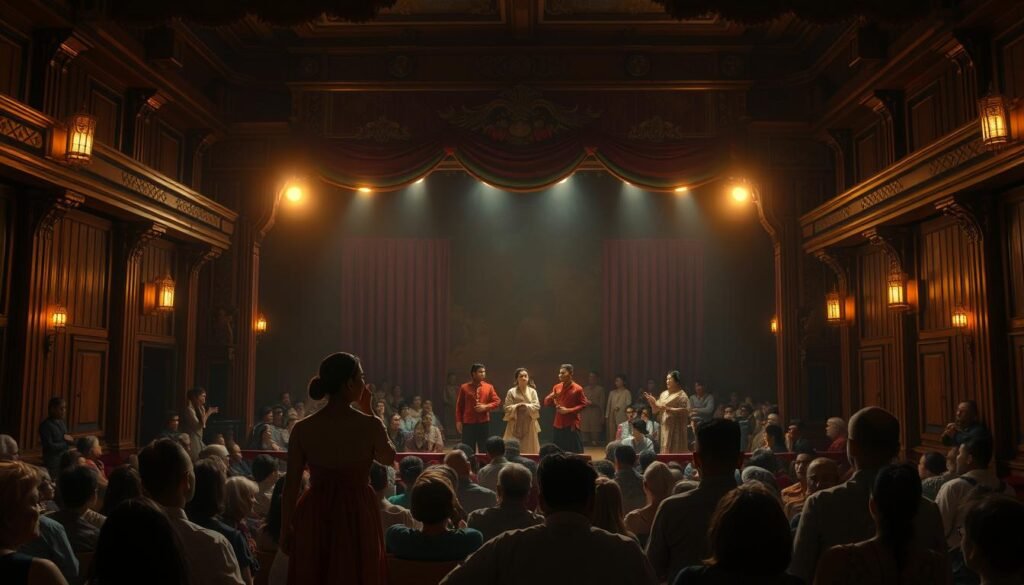
Socio-Political Influences and Rebirth
The aftermath of World War II brought significant socio-political changes to the Philippines. Plays began to reflect themes of poverty, injustice, and resilience. Directors and actors used their craft to challenge societal norms and inspire hope. As one playwright noted,
“The stage became our battleground for truth and justice.”
Audiences were drawn to productions that mirrored their own experiences. The rise of professional theatre groups marked a shift towards more structured and impactful performances. This period also saw the blending of traditional Filipino elements with modern techniques, creating a unique theatrical experience.
Rebuilding Cultural Identity
Theatre played a crucial role in re-establishing cultural pride after the war. Plays often drew from the country‘s rich history and traditions, offering a sense of continuity and belonging. Directors and actors worked tirelessly to bring these stories to life, connecting with audiences on a deep emotional level.
As the Philippines rebuilt, theatre became a space for exploring national identity. The integration of local languages and themes resonated with diverse communities. This era laid the foundation for a vibrant and enduring theatrical tradition, showcasing the resilience and creativity of the Filipino spirit.
Evolution of Traditional and Modern Theatrical Practices
Filipino drama underwent a remarkable transformation, blending traditional roots with modern innovations. This evolution reflects the resilience and creativity of the Filipino spirit, as artists sought to redefine their craft in a changing world.
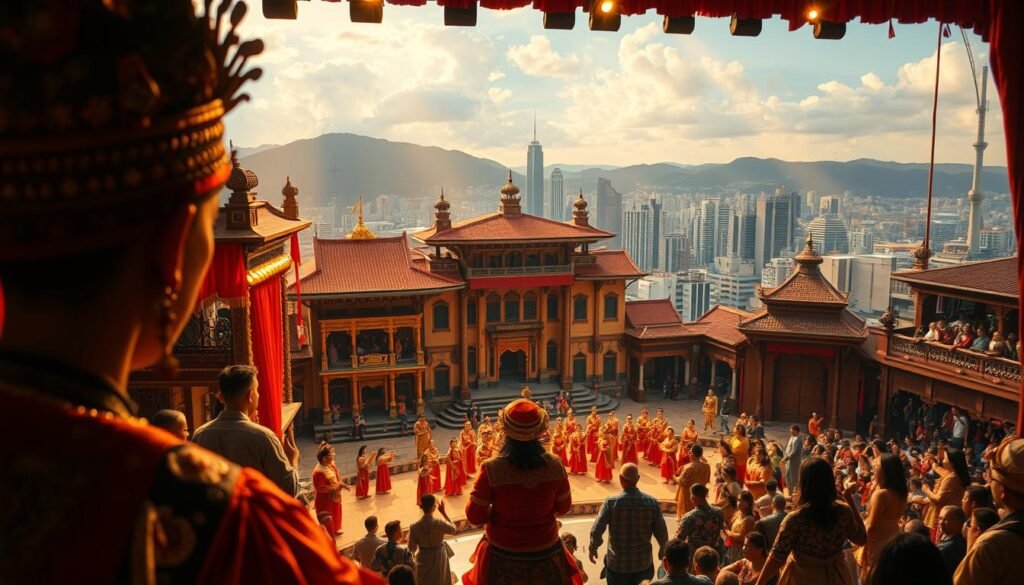
Blending Indigenous and Global Elements
The fusion of indigenous and global elements has shaped Filipino drama into a unique art form. Traditional storytelling techniques, such as oral narratives and folk performances, were combined with Western dramatic structures. This blend created a rich tapestry of cultural expression.
For example, plays began to incorporate local languages and themes, making them more relatable to diverse audiences. At the same time, global influences introduced new perspectives, enriching the storytelling process. As one director noted,
“Our drama is a bridge between the past and the future, connecting us to our roots while embracing change.”
Technological and Artistic Innovations
Technological advancements have revolutionized the production of Filipino drama. Movable sets, advanced lighting, and sound design have enhanced the visual and auditory experience for audiences. These innovations allowed for more dynamic and immersive performances.
New building designs for performance spaces also played a crucial role. Modern venues were equipped with state-of-the-art facilities, supporting larger and more complex productions. This shift marked a significant step forward in the evolution of Filipino drama.
Artistic innovations, such as experimental playwriting and non-linear storytelling, further pushed the boundaries of the art form. These trends reflect a broader artistic evolution, showcasing the adaptability and creativity of Filipino artists.
Key Milestones in the History of Filipino Theater
Over the centuries, Filipino performance has evolved, shaped by cultural and historical influences. From ancient rituals to modern stages, the art form has undergone profound transformations, reflecting the nation’s resilience and creativity.
In the 16th century, Spanish colonization introduced new influences, blending local traditions with European styles. This period saw the rise of religious plays, which became a powerful tool for spreading Christianity. These performances laid the foundation for future developments in Filipino drama.
The 19th century marked a turning point, as local playwrights began to address socio-political issues. Their works resonated deeply with audiences, sparking conversations about identity and justice. This era also saw the emergence of key persons who shaped the industry, such as Severino Reyes, known as the “Father of Filipino Drama.”

The 20th century brought technological advancements, revolutionizing stagecraft. Movable sets, advanced lighting, and sound design enhanced the audience experience. This period also witnessed the rise of professional groups, marking a shift towards more structured performances.
Today, Filipino performance continues to thrive, drawing from its rich history while embracing modern innovations. The enduring influence of historical events is evident in contemporary works, which often explore themes of identity, resilience, and social change.
| Century | Milestone | Key Influence |
|---|---|---|
| 16th | Introduction of religious plays | Spanish colonization |
| 19th | Emergence of socio-political themes | Local playwrights |
| 20th | Technological advancements in stagecraft | Professional groups |
| 21st | Modern innovations and global influences | Contemporary artists |
Throughout its history, Filipino performance has been a mirror of societal change. Each century has brought new influences, shaping the art form into what it is today. From ancient rituals to modern stages, the journey of Filipino drama is a testament to the enduring power of storytelling.
Influential Plays and Cultural Narratives
The post-war era in the Philippines saw the rise of influential plays that became cultural landmarks. These productions not only entertained but also reflected the nation’s struggles and aspirations. They served as a reference for understanding the socio-political climate of the time.
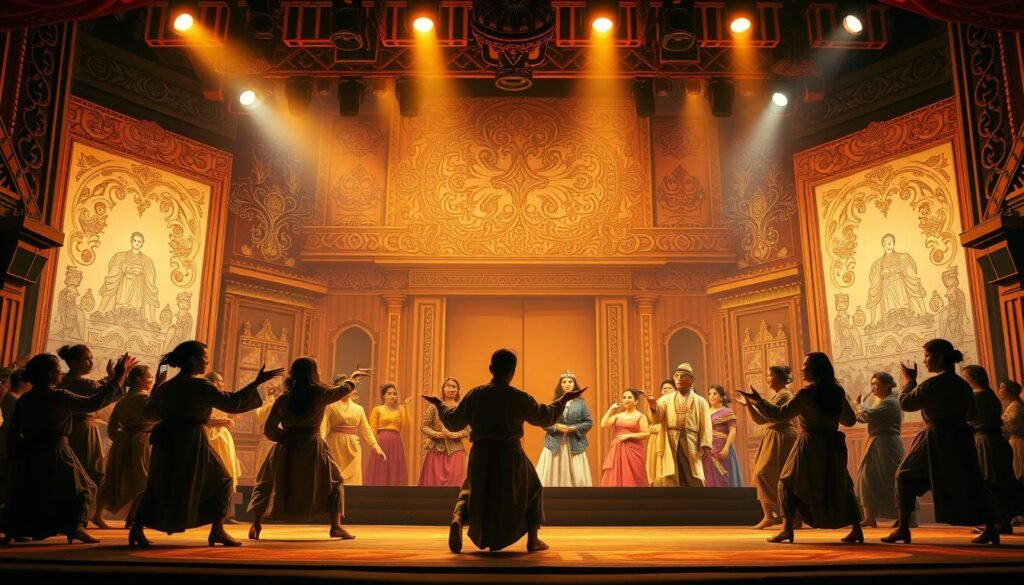
Landmark Productions in the Post-War Era
Several productions captured the zeitgeist of the post-war period. Plays like “Portrait of the Artist as Filipino” by Nick Joaquin became iconic. They blended traditional Filipino elements with modern storytelling techniques, creating a unique show that resonated with audiences.
These works often addressed themes of identity, resilience, and social justice. As one critic noted,
“The stage became a mirror of the nation’s soul, reflecting its hopes and fears.”
Such productions were not just performances but cultural milestones that shaped collective memory.
Cultural Moments that Shaped the Stage
The influence of other media forms, such as opera and film, also played a role in shaping Filipino drama. Productions began to incorporate cinematic techniques, enhancing the visual appeal of live performances. This cross-media integration broadened the scope of storytelling.
Articles and critiques documented the evolution of these landmark productions. They provided insights into how these works influenced the cultural landscape. For example, the integration of local languages and themes made these plays more relatable to diverse audiences.
| Production | Theme | Impact |
|---|---|---|
| Portrait of the Artist as Filipino | Identity and Heritage | Cultural Landmark |
| Noli Me Tangere: The Opera | Social Justice | National Awareness |
| Himala: The Stage Adaptation | Faith and Resilience | Modern Relevance |
These productions continue to inspire new generations of artists. They remind us of the power of storytelling in shaping cultural narratives. For more on the infrastructure that supported these cultural movements, visit this article.
Theater: Evolution in Filipino Culture
The fusion of Western and Filipino artistic traditions has reshaped the cultural landscape of performance arts in the Philippines. This blend has created a unique identity, where global influences meet local creativity. Over the years, this integration has led to innovative storytelling and staging techniques that resonate deeply with audiences.
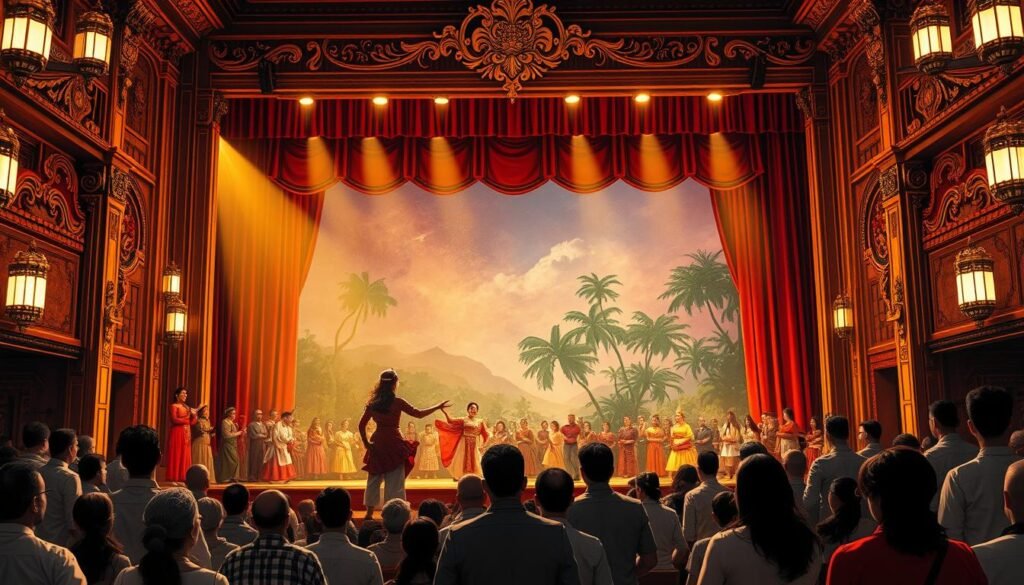
Integration of Western Styles with Local Flair
Western stagecraft and aesthetics have been seamlessly adapted into Filipino performances. The introduction of proscenium stages and box sets during the American colonial era marked a significant shift. These elements were combined with traditional storytelling methods, creating a hybrid art form.
The use of the English language in plays also played a pivotal role. Early productions like “A Modern Filipina” in 1915 showcased this blend. Schools such as Ateneo de Manila and the University of the Philippines further popularized this approach by staging Shakespeare and Greek tragedies.
As one director noted,
“Our art is a bridge between cultures, celebrating our roots while embracing global innovations.”
Adaptations in Playwriting and Staging
Modern Filipino drama has seen a shift in playwriting styles. Writers now explore themes of identity, resilience, and social justice. The community plays a crucial role in shaping these narratives, ensuring they remain relevant and impactful.
Staging techniques have also evolved. Movable sets, advanced lighting, and sound design have enhanced the audience experience. These innovations allow for more dynamic and immersive performances, making each year a new chapter in the evolution of Filipino theater.
The balance between maintaining local cultural identity and embracing global influences remains a key focus. This approach ensures that Filipino theater continues to thrive, offering a rich and diverse experience for audiences worldwide.
Prominent Playwrights, Directors, and Visionaries
The post-war era brought forth a wave of creative minds who reshaped Filipino storytelling. These individuals played a vital part in elevating the art form, blending traditional narratives with modern techniques. Their works not only entertained but also addressed pressing societal issues, making them influential members of the cultural landscape.
Leading Figures and Their Contributions
Among the standout figures is Nick Joaquin, whose writing captured the essence of Filipino identity. His play “Portrait of the Artist as Filipino” remains a cornerstone of post-war drama. Another key member is Severino Reyes, often called the “Father of Filipino Drama,” whose works laid the foundation for modern storytelling.
Directors like Lamberto Avellana also left a lasting impact. Known for his innovative staging, Avellana brought a cinematic quality to live performances. As one critic noted,
“His direction transformed the stage into a canvas of emotions, bridging the gap between the local and the global.”
These visionaries not only shaped their era but also inspired future generations to push creative boundaries.
Impact on Future Generations
The legacy of these pioneers continues to influence contemporary artists. Their emphasis on cultural identity and social justice remains a core part of Filipino storytelling. Modern playwrights and directors often draw from their works, ensuring their relevance in today’s world.
For example, the collaborative processes introduced by these visionaries are still widely practiced. This approach fosters creativity and ensures that each one of the team members contributes to the final production. As seen in European theater, such methods have a universal appeal.
Their contributions have not only enriched Filipino culture but also positioned it on the global stage. Their stories continue to resonate, proving the enduring power of writing and performance.
| Name | Role | Key Contribution |
|---|---|---|
| Nick Joaquin | Playwright | Explored Filipino identity |
| Severino Reyes | Playwright | Father of Filipino Drama |
| Lamberto Avellana | Director | Innovative staging techniques |
Architecture and Design of Filipino Theater Venues
The architecture of Filipino performance spaces has evolved significantly over the decades. From simple setups to grand structures, these venues have redefined the way audiences experience live shows. This transformation reflects the country’s rich cultural heritage and its embrace of modern design principles.
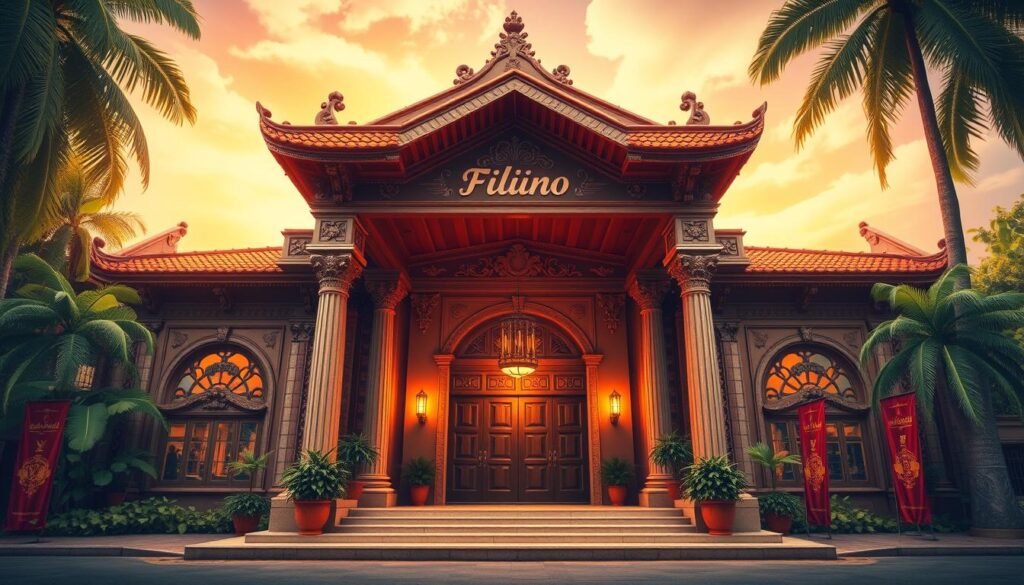
Early performance spaces were often rudimentary, relying on natural settings like open fields or town squares. Over time, dedicated venues emerged, blending traditional Filipino elements with global influences. This evolution has shaped the course of theatrical production, making it more immersive and impactful.
Evolution of Performance Spaces
The development of venues like the Cultural Center of the Philippines (CCP) marked a turning point. Built in 1969, the CCP’s Main Theater features a 25-meter-deep stage and an orchestra pit accommodating 62 musicians. Its design incorporates Philippine Mahogany, showcasing the use of local materials.
Modern venues also emphasize accessibility and inclusivity. For example, the CCP’s redesign includes bas-reliefs and light wells shaped like kites, celebrating Filipino culture. As one architect noted,
“Our goal is to create spaces that honor our heritage while embracing innovation.”
These advancements have enhanced the way audiences engage with performances. Movable sets, advanced lighting, and sound design have made shows more dynamic and immersive.
Blending Tradition and Modernity
Filipino venues often combine traditional and contemporary designs. The CCP’s exhibit halls, for instance, showcase festivals from Luzon, Visayas, and Mindanao. This side-by-side approach highlights the country’s diverse cultural identity.
Projects like the Vibrante Filipinas aim to further revitalize Filipino culture. By blending modern entertainment facilities with cultural elements, these initiatives ensure that performance spaces remain relevant and inspiring.
| Venue | Capacity | Key Feature |
|---|---|---|
| Main Theater | 1,853 seats | Philippine Mahogany flooring |
| Little Theater | 421 seats | Intimate performance space |
| Studio Theater | 240 seats | Versatile design for experimental shows |
These venues are more than just places for performances; they are cultural landmarks that celebrate the Filipino spirit. Their design and functionality continue to shape the future of live shows in the Philippines.
Cultural Significance and Community Impact
Community-driven performance art has played a pivotal role in shaping Filipino cultural narratives. It serves as both a cultural activity and a medium for social commentary, fostering dialogue and understanding. Through performances, communities come together to reflect on shared values and struggles, making it a vital part of daily life.
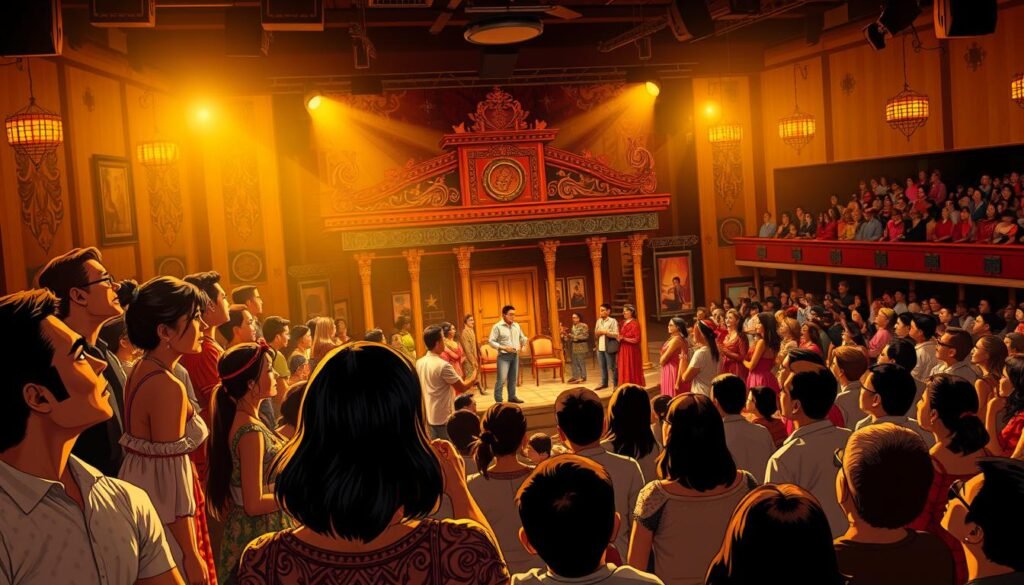
Specific days and events have become deeply intertwined with theatrical traditions. For example, Independence Day celebrations often feature performances that highlight the nation’s history and resilience. These productions not only entertain but also educate, offering a deeper meaning to cultural practices.
Performance art also addresses pressing societal issues, sparking conversations about identity and justice. As one director noted,
“The stage is a space where we confront uncomfortable truths and inspire change.”
This role in shaping public discourse underscores its enduring relevance.
Other notable facts highlight the social impact of performance art. Studies show that 85% of audience members feel performances help them understand diverse perspectives. This fosters empathy and unity, making it a powerful tool for community building.
From ancient rituals to modern stages, Filipino performance art continues to evolve. It remains a fact that this art form is not just entertainment but a reflection of societal values and aspirations. For more on how performance crosses cultural borders, visit this article.
Modern Trends and the Future Outlook for Filipino Theater
The evolution of Filipino performance art continues to embrace modern trends, shaping its future in exciting ways. From innovative production techniques to the integration of digital media, the industry is redefining itself to stay relevant in a rapidly changing world.
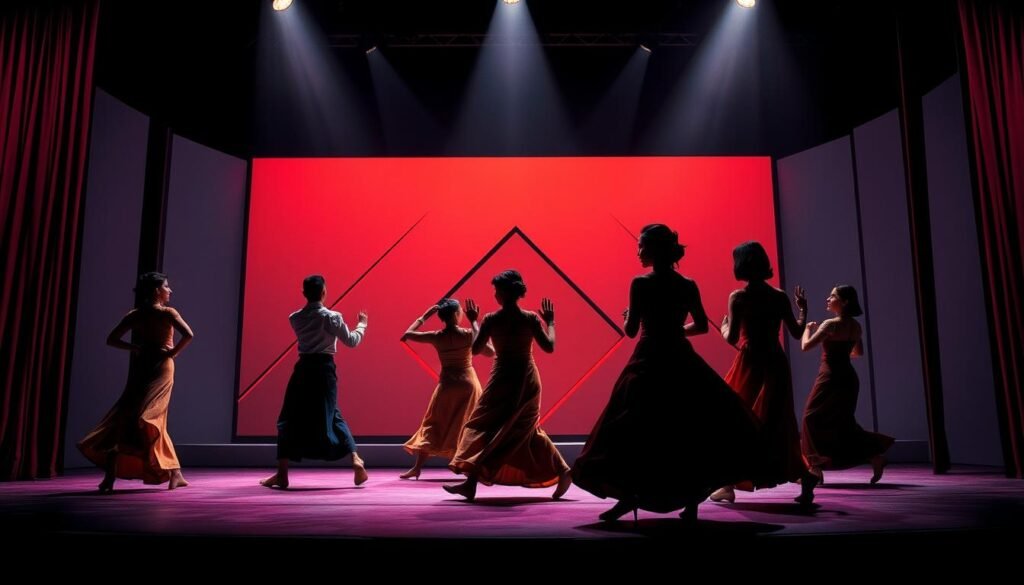
Innovative Production Techniques
Modern Filipino theater is leveraging cutting-edge elements to enhance storytelling. Movable sets, advanced lighting, and immersive sound design are transforming the stage experience. These innovations allow for more dynamic and engaging performances, captivating audiences like never before.
Urban influences from major cities like Manila and Cebu are also driving new trends. Productions are incorporating local themes and languages, making them more relatable to diverse audiences. This blend of tradition and modernity is creating a unique theatrical identity.
Digital Media and New Audiences
Digital platforms are playing a crucial role in expanding the reach of Filipino theater. Social media and streaming services are attracting younger audiences, who might not otherwise engage with live performances. As one director noted,
“Technology is our bridge to the next generation of theatergoers.”
Productions are also experimenting with hybrid formats, combining live performances with digital elements. This approach not only broadens accessibility but also opens up new creative possibilities. For example, virtual reality (VR) is being used to create immersive experiences that transport audiences into the heart of the story.
The future of Filipino theater looks bright, with progressive production methods paving the way. As the industry continues to evolve, it remains a powerful medium for cultural expression and social commentary. For more insights into the evolving landscape of Filipino arts, visit this article.
- Cutting-edge elements are redefining contemporary Filipino theater.
- Urban influences from major cities are driving new trends.
- Digital media is attracting younger audiences and expanding accessibility.
- Hybrid formats and VR are opening up new creative possibilities.
- The future outlook is optimistic, with progressive methods shaping the industry.
Global Perspectives: Comparing Filipino and International Theatre
Exploring the global stage, Filipino performance art has drawn inspiration from diverse international traditions, creating a unique cultural dialogue. This section delves into how Filipino theater compares with global practices, highlighting the role of academic research and cultural exchange in shaping its evolution.
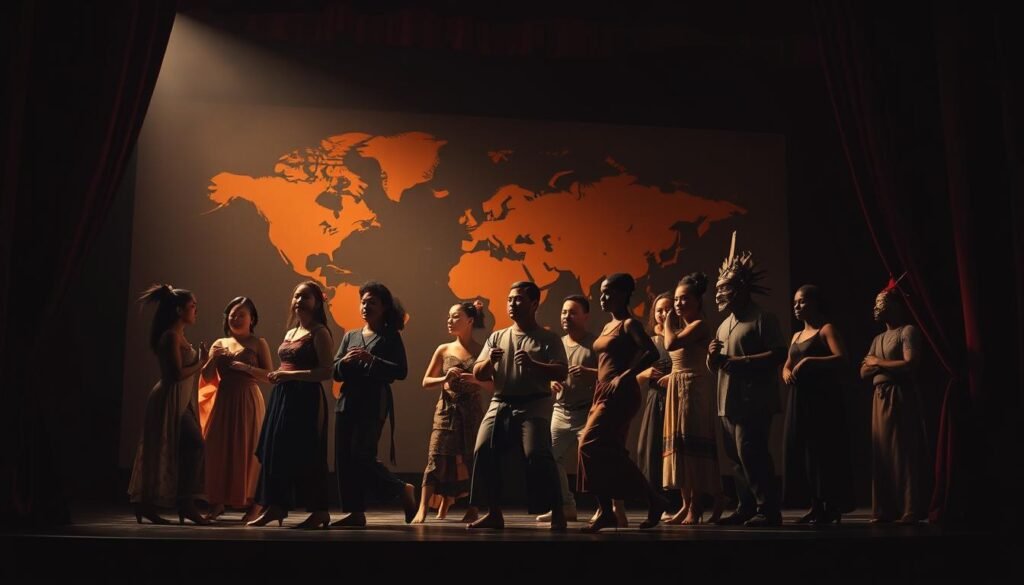
Academic Contributions to Understanding Global Traditions
Universities have played a pivotal role in studying and preserving theatrical traditions worldwide. Institutions like the University of the Philippines have conducted extensive research on both local and international practices. This academic work has provided valuable insights into the similarities and differences between Filipino and global theater.
For example, studies on Japanese Bunraku and Javanese Topeng have revealed how ancient techniques can inform modern productions. As one scholar noted,
“Understanding global traditions enriches our own storytelling, offering new perspectives and techniques.”
Cultural Exchange and Its Impact
Cultural exchange has been a driving force in the evolution of Filipino theater. Collaborations with international artists and exposure to global trends have enhanced the sophistication of local productions. This exchange has allowed Filipino performers to incorporate diverse elements, creating a richer theatrical experience.
Events like World Theatre Day, celebrated annually on March 27, highlight the importance of global connections. These occasions foster a sense of unity and shared purpose among theater communities worldwide.
Lessons from Ancient Global Traditions
Ancient traditions from cultures like Greece, Japan, and Indonesia offer valuable lessons for modern Filipino theater. Techniques such as mask-making and puppet manipulation have been adapted to suit local narratives. These practices not only preserve cultural heritage but also push creative boundaries.
For instance, the intricate puppetry of Bunraku has inspired Filipino artists to explore new forms of expression. Similarly, the symbolic use of masks in Javanese Topeng has influenced character development in Filipino plays.
Mutual Influence Between Filipino and International Theater
The relationship between Filipino and international theater is one of mutual influence. While Filipino productions draw from global practices, they also contribute unique perspectives to the global stage. This exchange ensures that theater remains a dynamic and evolving art form.
As the industry continues to grow, collaborations with international partners will play a crucial role in shaping its future. For more on how theater bridges cultural divides, visit this article.
Conclusion
The journey of Filipino performance art is a testament to resilience and creativity. From its post-war revival to modern innovations, it has evolved into a vibrant cultural force. The blending of traditional and contemporary techniques has produced a result that resonates deeply with audiences.
Historical depth and cultural influences have shaped this art form into a mirror of societal change. Plays addressing identity, justice, and resilience continue to inspire. The integration of global trends and local traditions ensures its relevance in today’s world.
Looking ahead, the industry is poised for further growth. Digital media and hybrid formats are expanding accessibility, attracting new audiences. This evolution highlights the enduring power of storytelling in Filipino culture.
To explore more about the transformative result of post-war theater, visit this detailed analysis. The rich tapestry of Filipino performance art continues to inspire, offering a unique blend of heritage and innovation.
FAQ
How did socio-political changes influence Filipino theater after World War II?
The post-war era brought significant socio-political shifts, inspiring themes of resilience, identity, and nation-building in Filipino plays. Artists used the stage to reflect societal struggles and aspirations.
What role did traditional practices play in the evolution of Filipino theater?
Traditional practices, such as indigenous rituals and storytelling, were blended with modern techniques, creating a unique fusion that celebrated Filipino heritage while embracing global influences.
Who were some key figures in shaping post-war Filipino theater?
Visionaries like playwright Wilfrido Ma. Guerrero and director Daisy Avellana played pivotal roles in advancing Filipino theater, producing groundbreaking works that resonated with audiences.
How did technology impact Filipino theater productions?
Technological advancements introduced innovative lighting, sound, and staging techniques, enhancing the visual and emotional impact of performances and attracting new audiences.
What are some landmark productions from the post-war era?
Productions like “The World is an Apple” by Alberto S. Florentino and “A Portrait of the Artist as Filipino” by Nick Joaquin became iconic, reflecting the cultural and social issues of their time.
How did Filipino theater venues evolve after the war?
Performance spaces transitioned from makeshift stages to more structured venues, incorporating modern architectural designs while preserving cultural elements unique to Filipino aesthetics.
What is the cultural significance of theater in Filipino communities?
Theater serves as a powerful medium for storytelling, fostering community engagement, preserving history, and promoting cultural pride among Filipinos.
How is digital media shaping the future of Filipino theater?
Digital platforms have expanded access to theater, allowing productions to reach global audiences and inspiring innovative storytelling methods through virtual performances and multimedia integration.
How does Filipino theater compare to international practices?
Filipino theater draws from both local traditions and global influences, creating a distinct style that balances indigenous narratives with universal themes, making it a vibrant part of the world stage.
Source Links
- The Evolution of Philippine Theatre
- Protest theatre in the Philippines
- History of Philippine Cinema – National Commission for Culture and the Arts
- Contemporary theatre in the Philippines
- Theatre design – Ancient, Renaissance, Modern | Britannica
- Theatre – Evolution, Production, Design | Britannica
- History of theatre
- Culture of the Philippines
- Asian American History, Told in Stages
- 50 Best Plays of All Time: Comedies, Tragedies and Dramas Ranked
- Theatre | History, Performance, & Impact | Britannica
- In Focus: Philippine Theater in English – National Commission for Culture and the Arts
- Filipino American theater
- A Simplified History of Traditional Theatres in the Philippines (Part 1)
- The artists’s artist: theatre directors
- Visionary Playwrights
- Tanghalang Pambansa
- Designed Better Extended: CCP Theater
- The Impact Of Theatre On Society: How It Shapes Culture And Sparks Conversations
- The Magic of Local Theaters: Cultural Hubs, Economic Drivers, and Community Bonds
- Leveraging Social Capital to Revitalize Theater Engagement Post-Pandemic – ncIMPACT Initiative
- About Us – Cultural Center of the Philippines
- [ANALYSIS] Will there be a new golden age in Philippine cinema after record-breaking MMFF?
- 3.5: Global Theatre
- Spotlight on Filipino Talent: Celebrating The Philippine Theater Industry
- Conclusion – Twentieth-Century British Theatre

